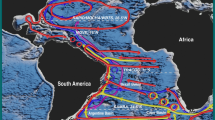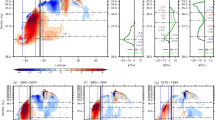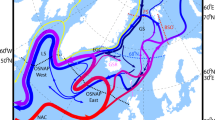Abstract
The meridional overturning circulation of the ocean plays a central role in climate and climate variability by storing and transporting heat, fresh water and carbon around the globe. Historically, the focus of research has been on the North Atlantic Basin, a primary site where water sinks from the surface to depth, triggered by loss of heat, and therefore buoyancy, to the atmosphere. A key part of the overturning puzzle, however, is the return path from the interior ocean to the surface through upwelling in the Southern Ocean. This return path is largely driven by winds. It has become clear over the past few years that the importance of Southern Ocean upwelling for our understanding of climate rivals that of North Atlantic downwelling, because it controls the rate at which ocean reservoirs of heat and carbon communicate with the surface.
This is a preview of subscription content, access via your institution
Access options
Subscribe to this journal
Receive 12 print issues and online access
$259.00 per year
only $21.58 per issue
Buy this article
- Purchase on Springer Link
- Instant access to full article PDF
Prices may be subject to local taxes which are calculated during checkout





Similar content being viewed by others
References
Stommel, H. The abyssal circulation. Letter to the editors. Deep-Sea Res. 5, 80–82 (1958).
Hughes, G. O. & Griffiths, R. W. A simple convective model of the global overturning circulation, including effects of entrainment into sinking regions. Ocean Model. 12, 46–79 (2006).
Marshall, J. & Schott, F. Open ocean deep convection: Observations, models and theory. Rev. Geophys. 37, 1–64 (1999).
Munk, W. Abyssal recipes. Deep-Sea Res. 13, 707–730 (1966).
Munk, W. & Wunsch, C. Abyssal recipes II: Energetics of tidal and wind mixing. Deep-Sea Res. 145, 1977–2010 (1998).
Toole, J. M. The Brazil Basin tracer release experiment. Int. WOCE Newsl. 28, 25–28 (1997).
Kunze, E., Firing, E., Hummon, J., Chereskin, T. & Thurnherr, A. M. Global abyssal mixing inferred from lowered adcp shear and ctd strain profiles. J. Phys. Oceanogr. 36, 1553–1576 (2006).
Ledwell, J. R., Watson, A. J. & Law, C. S. Mixing of a tracer in the pycnocline. J. Geophys. Res. 103, 21499–21529 (1998).
Ledwell, J. R., St Laurent, L. C., Girton, J. B. & Toole, J. M. Diapycnal mixing in the Antarctic circumpolar current. J. Phys. Oceanogr. 41, 241–246 (2011).
Sverdrup, H. U. On vertical circulation in the ocean due to the action of the wind with application to conditions within the Antarctic Circumpolar Current. Discov. Rep. VII, 139–170 (1933).
Döös, K. & Webb, D. J. The deacon cell and the other meridional cells of the southern ocean. J. Phys. Oceanogr. 24, 429–442 (1994).
Toggweiler, J. R. & Samuels, B. Effect of Drake Passage on the global thermohaline circulation. Deep-Sea Res. I 42, 477–500 (1995).
Toggweiler, J. R. & Samuels, B. On the ocean’s large-scale circulation near the limit of no vertical mixing. J. Phys. Oceanogr. 28, 1832–1852 (1998).
Webb, D. J. & Suginohara, N. in Ocean Circulation and Climate (eds Siedler, G., Church, J. & Gould, J.) Chapter 4.2, 205–214 (Int. Geophys. Ser., vol. 77, Academic, 2001).
Deacon, G. E. R. The hydrology of the Southern Ocean. Discov. Rep. 15, 1–124 (1937).
Wyrtki, K. The Antarctic circumpolar current and the Antarctic polar front. Dtsch. Hydrogr. Z. 13, 153–174 (1960).
Jacobs, S. & Georgi, D. T. Observations on the southwest Indian/Antarctic Ocean. Deep-Sea Res. 24, 43–84 (1977).
McCartney, M. S. in A Voyage of Discovery: George Deacon 70th Anniversary Volume (ed. Angel, M. V.) 103–119 (Supplement to Deep-Sea Research, vol. 24, Pergamon, 1977).
Whitworth, T. III, Orsi, A. H., Kim, S-J., Nowlin, W. D. Jr & Locarnini, R. A. in Ocean, Ice, and Atmosphere: Interactions at the Antarctic Continental Margin Vol. 75 (eds Jacobs, S. S. & Weiss, R. F.) (Antarctic Research Series, American Geophysical Union, 1998).
Nowlin, W. D. & Klinck, J. M. The physics of the Antarctic Circumpolar Current. Rev. Geophys. Space Phys. 24, 469–491 (1986).
Orsi, A. H., Whitworth, T.W. III & Nowlin, W. D. Jr On the meridional extent and fronts of the Antarctic Circumpolar Current. Deep-Sea Res. 42, 641–673 (1995).
Pollard, R. T., Lucas, M. I. & Read, J. F. Physical controls on biogeochemical zonation in the Southern Ocean. Deep-Sea Res. II 49, 3289–3305 (2002).
Sloyan, B. M. & Rintoul, S. R. The Southern Ocean limb of the global deep overturning circulation. J. Phys. Oceanogr. 31, 143–173 (2001).
Talley, L. D., Reid, J. L. & Robbins, P. E. Data-based meridional overturning streamfunctions for the global ocean. J. Clim. 16, 3213–3226 (2003).
Lumpkin, R. & Speer, K. Global ocean meridional overturning. J. Phys. Oceanogr. 37, 2550–2562 (2007).
Speer, K., Rintoul, S. R. & Sloyan, B. The diabatic Deacon Cell. J. Phys. Oceanogr. 30, 3212–3222 (2000).
Karsten, R. & Marshall, J. Inferring the residual circulation of the Antarctic circulation current from observations using dynamical theory. J. Phys. Oceanogr. 32, 3315–3327 (2002).
Marshall, J., Shuckburgh, E., Jones, H. & Hill, C. Estimates and implications of near-surface eddy diffusivities deduced by trace transport in the southern ocean. J. Phys. Oceanogr. 36, 1806–1821 (2006).
Zika, J. D., Sloyan, B. M. & McDougall, T. J. Diagnosing the Southern Ocean overturning from tracer fields. J. Phys. Oceanogr. 39, 2926–2940 (2009).
Jenkins, A. & Jacobs, S. Circulation and melting beneath George VI Ice Shelf, Antarctica. J. Geophys. Res. 113, C04013 (2008).
Warren, B., LaCasce, J. & Robbins, P. A. On the obscurantist physics of ‘form drag’ in theorizing about the Circumpolar Current. J. Phys. Oceanogr. 26, 2297–2301 (1996).
Toole, J. M. Sea ice, winter convection, and the temperature minimum layer in the Southern Ocean. J. Geophys. Res. 86, 8037–8047 (1981).
Rintoul, S., Hughes, C. & Olbers, D. in Ocean Circulation and Climate (eds Siedler, G., Church, J. & Gould, J.) Chapter 4.6, 271–302 (Int. Geophys. Ser., vol. 77, Academic, 2001).
Gill, A. E., Green, J. S. A. & Simmons, A. J. Energy partition in the large-scale ocean circulation and the production of midocean eddies. Deep-Sea Res. 21, 499–528 (1974).
Marshall, J. & Radko, T. Residual mean solutions for the Antarctic Circumpolar Current and its associated overturning circulation. J. Phys. Oceanogr. 33, 2341–2354 (2003).
Wunsch, C. The work done by the wind on the oceanic general circulation. J. Phys Oceanogr. 28, 2332–2340 (1998).
McWilliams, J. C., Holland, W. R. & Chow, J. S. A description of numerical Antarctic Circumpolar Currents. Dyn. Atmos. Oceans 2, 213–291 (1978).
Marshall, J. On the parameterization of geostrophic eddies in the ocean. J. Phys. Oceanogr. 11, 1257–1271 (1981).
deSzoeke, R. A. & Levine, M. D. The advective flux of heat by mean geostrophic motions in the Southern Ocean. Deep-Sea Res. A 28, 1057–1085 (1981).
Johnson, G. C. & Bryden, H. L. On the size of the Antarctic Circumpolar Current. Deep-Sea Res. 36, 39–53 (1989).
Gnanadesikan, S. A simple predictive model for the structure of the oceanic pycnocline. Science 283, 2077–2079 (1999).
Olbers, D. & Visbeck, M. A model of the zonally-averaged stratification and overturning in the southern ocean. J. Phys. Oceanogr. 35, 1190–1205 (2005).
Hallberg, R. & Gnanadesikan, A. The role of eddies in determining the structure and response of the wind-driven Southern Hemisphere overturning: results from the modeling eddies in the souther ocean (meso) project. J. Phys. Oceanogr. 36, 2232–2252 (2006).
Danabasoglu, G. & McWilliams, J. C. Sensitivity of the global ocean circulation to parameterization of mesoscale tracer transports. J. Clim. 8, 2967–2980 (1995).
Abernathey, R., Marshall, J. & Ferreira, D. Dependence of southern ocean overturning on wind stress. J. Phys. Oceanogr. 41, 2261–2278 (2011).
Marshall, D. Subduction of water masses in an eddying ocean. J. Mar. Res. 55, 201–222 (1997).
Munk, W. H. & Palmen, E. Note on the dynamics of the Antarctic Circumpolar Current. Tellus 3, 53–55 (1951).
Gille, S. The Southern Ocean momentum balance: Evidence for topographic effects from numerical model output and altimeter data. J. Phys. Oceanogr. 27, 2219–2231 (1997).
Rhines, P. B. & Young, W. R. Homogenization of potential vorticity in planetary gyres. J. Fluid Mech. 122, 347–367 (1982).
Marshall, J. C., Olbers, D., Wolf-Gladrow, D. & Ross, H. Potential vorticity constraints on the hydrography and transport of the southern oceans. J. Phys. Oceanogr. 23, 465–487 (1993).
Gent, P. R. & McWilliams, J. C. Isopycnal mixing in ocean circulation models. J. Phys. Oceanogr. 20, 150–155 (1990).
Alley, R. B. Abrupt climate change. Science 299, 2005–2010 (2003).
Huybers, P. & Wunsch, C. Paleophysical oceanography with an emphasis on transport rates. Annu. Rev. Marine Sci. 2, 1–34 (2010).
Sigman, D. & Boyle, E. Glacial/interglacial variations in atmospheric carbon dioxide. Nature 407, 859–869 (2000).
Sarmiento, J. L. & Toggweiler, J. R. A new model for the role of the oceans in determining atmospheric CO2 . Nature 308, 621–624 (1984).
Knox, F. & McElroy, M. B. Changes in atmospheric CO2: Influence of the marine biota at high latitude. J. Geophys. Res. 89, 4629–4637 (1984).
Adkins, J. F., McIntyre, K. & Schrag, D. P. The salinity, temperature and δ18O of the glacial deep ocean. Science 298, 1769–1773 (2002).
Skinner, L. C., Fallon, S., Waelbroeck, C., Michel, E. & Barker, S. Ventilation of the deep southern ocean and deglacial CO2 Rise. Science 328, 1147–1151 (2010).
Anderson, R. F. et al. Wind-driven upwelling in the southern ocean and the deglacial rise in atmospheric CO2 . Science 323, 1443–1448 (2009).
Crosta, X., Pichon, J. J. & Burckle, L. H. Reappraisal of seasonal Antarctic sea-ice extent at the last glacial maximum. Geophys. Res. Lett. 25, 2703–2706 (1998).
Gersonde, R., Crosta, X., Abelmann, A. & Armand, L. Sea-surface temperature and sea ice distribution of the Southern Ocean at the EPILOG Last Glacial Maximum—a circum-Antarctic view based on siliceous microfossil records. Quat. Sci. Rev. 24, 869–896 (2005).
Stephens, B. & Keeling, R. The influence of Antarctic sea ice on glacial–interglacial CO2 variations. Nature 404, 171–174 (2000).
Stocker, T. F. The sea saw effect. Science 282, 61–62 (1998).
Toggweiler, J. R., Russell, J. L. & Carson, S. R. Midlatitude westerlies, atmospheric CO2, and climate change during the ice ages. Paleoceanography 21, PA2005 (2006).
Toggweiler, J. R. & Russell, J. Ocean circulation in a warming climate. Nature 451, 286–288 (2008).
Watson, A. J. & Naveria Garabato, A. C. The role of Southern Ocean mixing and upwelling in glacial–interglacial atmospheric CO2 change. Tellus B 58, 73–87 (2006).
Thompson, D. W. J. & Wallace, J. M. Annular modes in the extratropical circulation. Part I: Month-to-month variability. J. Clim. 13, 1000–1016 (2000).
Thompson, D. W. J. & Solomon, S. Interpretation of recent Southern Hemisphere climate change. Science 296, 895–899 (2002).
Thompson, D. W. J. et al. Signatures of the Antarctic ozone hole in Southern Hemisphere surface climate change. Nature Geosci. 4, 741–749 (2011).
Hall, A. & Visbeck, M. Synchronous variability in the Southern Hemisphere atmosphere, sea ice, and ocean resulting from the annular mode. J. Clim. 15, 3043–3057 (2002).
Hogg, A., Meredith, M. P., Blundell, J. R. & Wilson, C. Eddy heat flux in the Southern Ocean: Response to variable wind forcing. J. Clim. 21, 608–620 (2008).
Martinson, D. G., Stammerjohn, S. E., Ianuzzi, R. A., Smith, R. C. & Vernet, M. Western Antarctic Peninsula physical oceanography and spatio-temporal variability. Deep-Sea Res. II 55, 1964–1987 (2008).
Holland, P. R., Jenkins, A. & Holland, D. M. Ice and ocean processes in the Bellingshausen Sea, Antarctica. J. Geophys. Res. 115, C05020 (2010).
Gordon, A. Lamont–Doherty Geological Observatory 1990 & 1991 Report 44–51 (Lamont-Doherty Geological Observatory of Columbia Univ., 1991).
Russell, J. L., Dixon, K. W., Gnanadesikan, A., Stouffer, R. J. & Toggweiler, J. R. The Southern Hemisphere westerlies in a warming world: Propping open the door to the deep ocean. J. Clim. 19, 6382–6390 (2006).
Boening, C. W., Dispert, A. & Visbeck, M. The response of the Antarctic Circumpolar Current to recent climate change. Nature Geosci. 1, 864–869 (2008).
Wong, A. P. S., Bindoff, N. L. & Church, J. A. Large-scale freshening of intermediate waters in the Pacific and Indian oceans. Nature 400, 440–443 (1999).
Durack, P. J. & Wijffels, S. E. Fifty-year trends in global ocean salinities and their relationship to broad-scale warming. J. Clim. 23, 4342–4362 (2010).
Gille, S. Decadal-scale temperature trends in the Southern Hemisphere ocean. J. Clim. 21, 2749–2765 (2008).
Purkey, S. G. & Johnson, G. C. Warming of global abyssal and deep southern ocean waters between the 1990s and 2000s: Contributions to global heat and sea level rise budgets. J. Clim. 23, 6336–6351 (2010).
Fyfe, J. C., Saenko, O. A., Zickfeld, K., Eby, M. & Weaver, A. J. The role of poleward-intensifying winds on Southern Ocean warming. J. Clim. 20, 5391–5400 (2007).
Henning, C. C. & Vallis, G. K. The effects of mesoscale eddies on the stratification and transport of an ocean with a circumpolar channel. J. Phys. Oceanogr. 35, 880–897 (2005).
Hallberg, R. & Gnanadesikan, A. The role of eddies in determining the structure and response of the wind-driven Southern Hemisphere overturning: Results from the modeling eddies in the southern ocean (meso) project. J. Phys. Oceanogr. 36, 2232–2252 (2006).
Treguier, A. M., Le Sommer, J., Molines, J. M. & de Cuevas, B. Response of the Southern Ocean to the southern annular mode: Interannual variability and multidecadal trend. J. Phys. Oceanogr. 40, 1659–1668 (2010).
Caldeira, K. & Duffy, P. B. The role of the Southern Ocean in uptake and storage of anthropogenic carbon dioxide. Science 287, 620–622 (2000).
Sabine, C. L. et al. The oceanic sink for anthropogenic CO2 . Science 305, 367–371 (2004).
Lenton, A. & Matear, R. J. Role of the Southern Annular Mode (SAM) in Southern Ocean CO2 uptake. Glob. Biogeochem. Cycles 21, GB2016 (2007).
Sarmiento, J. L., Gruber, N., Brzezinski, M. A. & Dunne, J. P. High-latitude controls of thermocline nutrients and low latitude biological productivity. Nature 427, 56–60 (2004).
Mignone, B. K., Gnanadesikan, A, Sarmiento, J. L. & Slater, R. D. Central role of Southern Hemisphere winds and eddies in modulating the anthropogenic carbon. Geophys. Res. Lett. 33, L01604 (2006).
Ito, T., Marshall, J. & Follows, M. What controls the uptake of transient tracers in the Southern Ocean? Glob. Biogeochem. Cycles 18, GB2021 (2004).
le Quéré, C., Rodenbeck, C. & Buitenhuis, E. T. Saturation of the Southern Ocean CO2 sink due to recent climate change. Science 316, 1735–1738 (2007).
Lovenduski, N. S., Gruber, N. & Doney, S. C. Toward a mechanistic understanding of the decadal trends in the Southern Ocean carbon sink. Glob. Biogeochem. Cycles 22, GB3016 (2008).
Zickfeld, K., Fyfe, J. C., Eby, M. & Weaver, A. J. Comment on ‘Saturation of the Southern Ocean CO2 sink due to recent climate change’. Science 319, 570–571 (2008).
Meehl, G. A. et al. in IPCC Climate Change: The Physical Science Basis (eds Solomon, S. et al.) 747–845 (Cambridge Univ. Press, 2007).
Broecker, W. S. The biggest chill. Nat. Hist. Mag. 97, 74–82 (1987).
Broecker, W. S. The great ocean conveyor. Oceanography 4, 79–89 (1991).
Gordon, A. L. Interocean exchange of thermocline water. J. Geophys. Res. 91, 5037–5046 (1986).
Schmitz, W. J. Jr On the World Ocean Circulation, 1 & II, Tech. Rep. WHOI-96-O3&O8 (Woods Hole Oceanographic Institute, 1996).
Richardson, P. L. On the history of meridional overturning circulation schematic diagrams. Prog. Oceanogra. 76, 466–486 (2008).
Sverdrup, H. U., Johnson, M. W. & Fleming, R. H. The Oceans, their Physics, Chemistry, and General Biology (Prentice Hall, 1942).
Ren, L., Speer, K. & Chassignet, E. P. The mixed layer salinity budget and sea ice in the Southern Ocean. J. Geophys. Res. 116, C08031 (2011).
Acknowledgements
We would like to thank our many colleagues for discussions and comments during the writing of this Review: in particular, R. Abernathey, E. Boyle, J-M. Campin, D. Ferreira, R. Ferrari, M. Follows, P. Huybers, D. Marshall, D. McGee, R. Toggweiler, R. Tulloch and A. Watson. Thanks also to N. Wienders, R. Tulloch and R. Windman for help in preparation of the figures. This study was supported by the Polar Programs section of the National Science Foundation.
Author information
Authors and Affiliations
Corresponding author
Ethics declarations
Competing interests
The authors declare no competing financial interests.
Rights and permissions
About this article
Cite this article
Marshall, J., Speer, K. Closure of the meridional overturning circulation through Southern Ocean upwelling. Nature Geosci 5, 171–180 (2012). https://doi.org/10.1038/ngeo1391
Received:
Accepted:
Published:
Issue Date:
DOI: https://doi.org/10.1038/ngeo1391
This article is cited by
-
The role of mountains in shaping the global meridional overturning circulation
Nature Communications (2024)
-
The southward migration of the Antarctic Circumpolar Current enhanced oceanic degassing of carbon dioxide during the last two deglaciations
Communications Earth & Environment (2024)
-
Circum-Antarctic bottom water formation mediated by tides and topographic waves
Nature Communications (2024)
-
Southern Ocean glacial conditions and their influence on deglacial events
Nature Reviews Earth & Environment (2023)
-
Regional and global impact of CO2 uptake in the Benguela Upwelling System through preformed nutrients
Nature Communications (2023)



